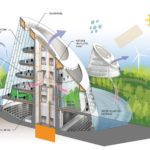Civil engineering is a career that is becoming increasingly important as demands for improved infrastructure, green initiatives, and efficient forms of building and traveling emerge.
With this increased pressure for civil engineers to innovate and continue positive growth comes an increase in specialization and disciplines that fall under the umbrella of civil engineering.
As a result, many different workers who consider themselves “civil engineers” could all have very different day to day tasks and projects that they work on. Currently, the most prominent types of civil engineers are structural engineers, geotechnical engineers, environmental engineers, water engineers, construction engineers, and transportation engineers.
Types of Civil Engineers
The list of civil engineering disciplines is ever expanding and even some of these subdisciplines have categories within them as well.
1. Structural Engineers
Structural engineers are involved in the design, analysis, and maintenance of structures like buildings and bridges. These structures are designed to fit budget requirements and strength loading and capacity factors from various sources.
They must consider the conditions that their structure will endure, including loads from people and vehicles as well as environmental loads such as wind and snow.
Structural engineers can be involved in many other types of civil engineering projects as well, as many works on designing telecom towers, tunnels, retaining walls, and more. Anywhere a structure needs built to resist loads, chances are there’s a structural engineer involved.
2. Geotechnical Engineers
Geotechnical engineers utilize their understanding of soil strength and structural design to design foundations, analyze pavement strengths and depths, assist in the design of dams, tunnels, embankments, levees, mines, and more.
Their understanding of soil, its strength, how it behaves under stress and when it’s saturated are important to virtually any construction project. Their foundation design can even span beyond buildings and into things such as cranes, platforms, and more.
The field of geotechnical engineering is constantly changing and many formulae and calculations that are used today weren’t around as little as 40 or 50 years ago.
3. Environmental Engineers
Environmental engineers are tasked with analyzing and avoiding potential environmental risks.
They are tasked with helping to protect preserved areas of nature and keep building sites, water sources, and air free of pollution and environmental detriment.
Environmental engineers must have a strong core understanding of science and math, including hydrology and drainage as well as air science.
4. Water Engineers
Water engineers might have some overlap with environmental engineers in that both can assist in keeping waterways and water sources clean, but water engineers are more focused on developing water distribution systems, water treatment systems, and waterways that are clean and efficient.
Furthermore, they assess the impacts and how to avoid flooding, keeping groundwater sources protected and clean, and mitigating soil erosion impacts in many areas, including along riverbanks and roadsides.
These engineers should have a strong comprehension of fluid dynamics, drainage, and environmental principles.
5. Construction Engineers
Construction engineers are generally on-site engineers at construction projects that ensure quality and best management practices when constructing any project.
They are generally employed by contracting companies who do the building for consulting or design-build companies.
They are needed for any construction project and thus they have the potential to see a wide range of projects unfold before them.
Construction Engineers are responsible for ensuring that a project is constructed safely and that there are no red flags that arise during construction.
6. Transportation Engineers
Transportation engineers have a wide range of responsibilities and are tasked with the design and maintenance of railroads, roadways, ports, airports, and any other system that accommodates passengers or commerce for transportation.
Beyond design, planning is an important aspect in determining the most effective routes and modes of transportation for a given area.
They can also analyze traffic and crash data to develop transportation systems that are safe and efficient. It’s their job to identify the transportation needs of a city, state, or country, and provide for those needs in a way that is safe, efficient, and cost-effective.
Civil Engineers in Projects
Civil engineers can be found in nearly every engineering company because they are so vital to the design and quality assurance of many disciplines that engineering disciplines such as mechanical, electrical, chemical, or biomedical might not cover.
They have an understanding of how infrastructure is built to withstand challenges from the environment, population growth, new technological innovations, and more.
Civil engineers are constantly developing better processes and designs to handle the new challenges that they face in a developing world. Their projects are often, but not always, public goods. Because of this, they are often using taxpayer money to fund their projects and give back in the form of some necessary infrastructure improvement such as a new road, a new building, improved utilities, or increased quality of water and environmental protections.
And they are also often employed by governments at every level: local, county, state, and federal, to manage these systems at each level and ensure that they’re properly maintained and developing new systems.
Civil Engineering Modern Challenges
The American Society of Civil Engineers has listed modern challenges to civil engineers:
- Being estimating sea levels
- Ensuring infrastructure resilience against natural
- Manmade disasters such as hurricanes or terrorism
- Improving the efficiency of buildings
- Managing groundwater sources
- Improving flow of traffic in heavily populated areas
- Improving the production and timeliness of construction
- Reducing soil erosion
- Ensuring that infrastructure is built to last and that it’s built in a safe manner for construction workers.
All of these tasks and more is what civil engineers will face on a daily basis going forward and they’re modern problems that require modern solutions. So expect to see developments in these areas from the newest generation of civil engineers.



